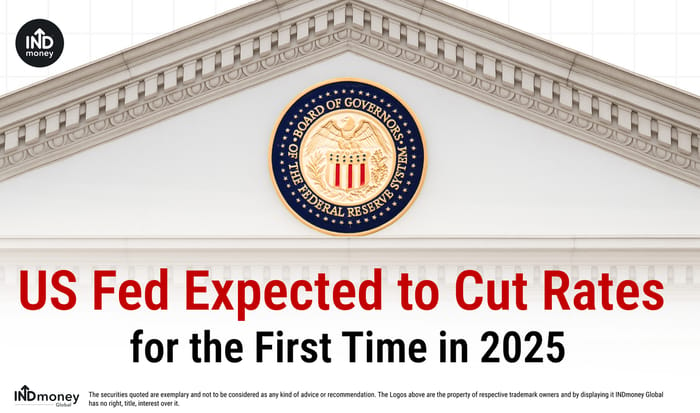
- What Markets Expect from the Fed’s September Decision?
- Why Is the Fed Cutting Rates?
- Politics and Policy Pressures in Play
- How Markets and the Economy Could React to Fed Rate Cuts?
- What Investors Should Keep an Eye On?
The Federal Reserve is widely expected to trim interest rates at its September 2025 policy meeting, the first step lower this year after holding borrowing costs at the highest levels in more than two decades. The shift comes as the job market cools, unemployment ticks up, and inflation, though easing, still runs slightly above the Fed’s 2% goal.
Let’s break down with this blog why the Fed is preparing to cut, what scale of reduction markets see coming, and how it could play out for households, businesses, and global investors.
What Markets Expect from the Fed’s September Decision?
Wall Street isn’t guessing on this one. The CME FedWatch Tool puts the odds of a 25 basis point cut at around 96%, which would take the federal funds rate down to 4.0-4.25% from the current 4.25-4.50% range.
Some officials have floated the idea of a bigger 50 bps move, but most expect the Fed to start small. Fed’s September 2025 Summary of Economic Projections (SEP) hints at more to come: its September outlook suggests rates may finish the year near 4.0-4.25% and could slide further, toward 3.0-3.25%, by the end of 2026.
That would bring US policy closer to the path already taken by the Bank of England, the European Central Bank, and the Bank of Canada, all of which have started easing as inflation cools.
Why Is the Fed Cutting Rates?
The decision is rooted in the Fed’s dual mandate. Both sides of it are flashing caution signs.
- Jobs are stalling: August saw just 22,000 new jobs, the weakest since late 2021. June even posted a rare net loss of 13,000. The unemployment rate has climbed to 4.3%.
- Inflation hasn’t fully settled: Overall inflation is running at 2.9% year-on-year, with core at about 3.1%. Higher tariffs and service costs are keeping prices sticky.
For policymakers, the trade-off is sharp: ease enough to protect jobs, but not so much that inflation finds new momentum.
Politics and Policy Pressures in Play
The economic data isn’t the only factor.
- White House pressure: President Donald Trump has repeatedly called for larger cuts to fuel growth before the 2026 election. That puts Powell and his colleagues under an extra spotlight.
- Divided committee: With new members joining the FOMC this year, more dissent is expected. Some want faster action, while others remain cautious about inflation.
- Fed credibility: Powell has stressed a “data-dependent” approach, but markets will watch closely to see if politics influences the tone or pace of cuts.
How Markets and the Economy Could React to Fed Rate Cuts?
If the Fed pulls the trigger, the effects will spread quickly:
- Cheaper borrowing: Mortgage, auto, and credit card rates should ease. But in housing, lower financing costs could push demand higher and paradoxically lift prices.
- Savings rates dip: Deposit and money market yields, which have been attractive lately, will start to fade.
- Markets react: Equities tend to benefit, bond yields fall, and prices rise.
- Bank margins narrow: Lenders may feel squeezed as loan rates drop faster than deposit costs.
- Dollar weakens: Exports get a boost, but imports become pricier.
The Fed is not alone. Central banks across Europe, the UK, and Canada have already shifted toward easier policy. By cutting now, the Fed signals it is willing to join that global cycle while still trying to keep inflation under control at home.
Powell’s press conference will be just as important as the decision itself. Investors will be parsing every line for signs of how quickly the Fed may move through late 2025 and into 2026.
What Investors Should Keep an Eye On?
- Tone of the Fed’s statement: Markets will look for whether the Fed sounds tentative or confident about inflation progress.
- Labor market updates: Jobs and wage data in the coming months will shape the pace of further cuts.
- Spillovers abroad: Emerging markets could see capital inflows on a weaker dollar, though volatility in flows is always a risk.
The September decision is about more than lowering borrowing costs. It marks the end of a long period where fighting inflation dominated policy. With other central banks already easing, the Fed’s move signals a turn toward supporting growth.
This is likely just the opening step in a broader cycle of cuts. For investors, the message is simple: the September meeting matters, but the real story will unfold over the months that follow.
Disclaimer:
The content is meant for education and general information purposes only. Investments in the securities market are subject to market risks, read all the related documents carefully before investing. Past performance is not indicative of future returns. The securities quoted are exemplary and are not a recommendation. This in no way is to be construed as financial advice or a recommendation to invest in any specific stock or financial instrument.The figures mentioned in this article are indicative and for general informational purposes only. Readers are encouraged to verify the exact numbers and financial data from official sources such as company filings, earnings reports, and financial news platforms. The Company strongly encourages its users/viewers to conduct their own research, and consult with a registered financial advisor before making any investment decisions. All disputes in relation to the content would not have access to an exchange investor redressal forum or arbitration mechanism. Registered office address: Office No. 507, 5th Floor, Pragya II, Block 15-C1, Zone-1, Road No. 11, Processing Area, GIFT SEZ, GIFT City, Gandhinagar – 382355. IFSCA Broker-Dealer Registration No. IFSC/BD/2023-24/0016, IFSCA DP Reg No: IFSC/DP/2023-24/010.